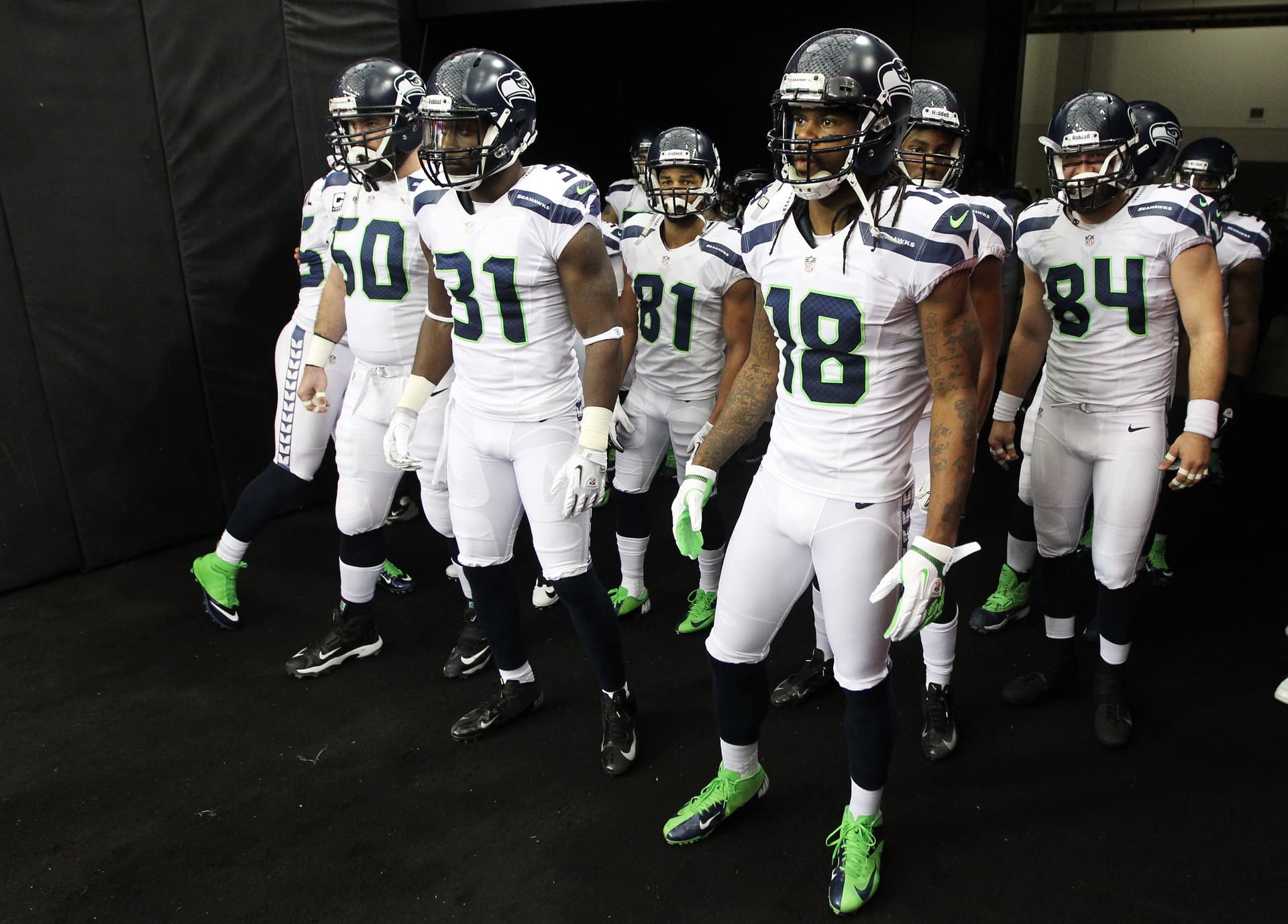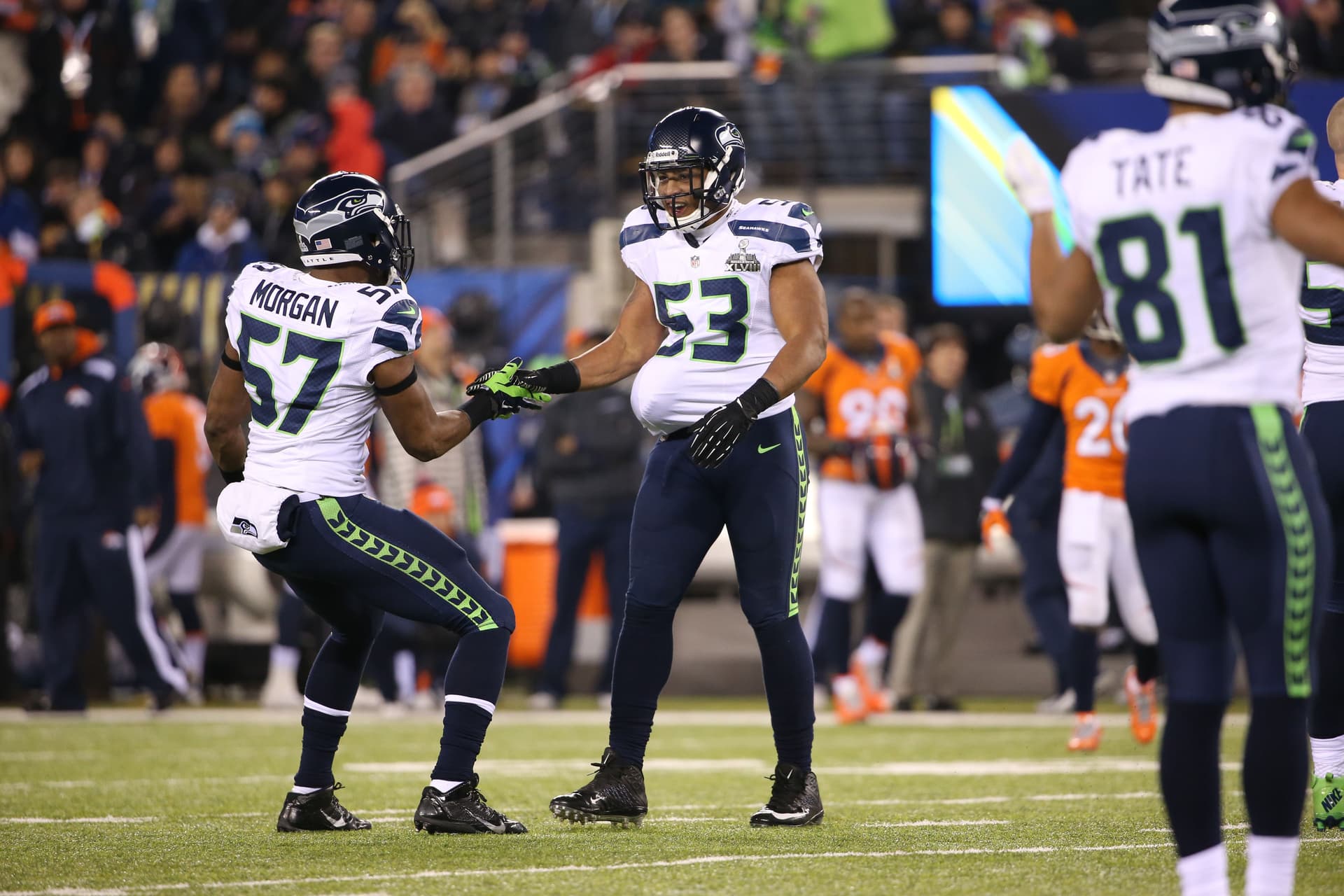NFL
Legion of Boom Era: Seattle Seahawk’s Fierce Defensive Team
The Seahawks defense of the 2012 to 2015 erected an unbeatable feat of scoring, owing to its defensive schemes, coordination, and tactics. The team introduced one of the league’s thinnest defensive playbook that would soon be replicated by the whole NFL.

Sidney Rice of the Seattle Seahawks with his teammates//Getty Images
During the 2010s, Seattle Seahawks provided their fans with eye-catching, irresistible matches. Fans could not desist from spending money on their favourite team’s jerseys, tickets, and other merchandise. The Seahawks were just getting started as they ushered in the Legion of Boom era that brought in a fierce defense, never seen before. The free to run, free to hit, and free to speak defense by Seattle Seahawks was a game changer.
In 2011, Seattle Seahawk’s defensive backfield culminated into a group known as the Legion of Boom. Originally, the backfield consisted of Richard Sherman, Earl Thomas, Kam Chancellor, Walter Thurmond, Brandon Browner, and Byron Maxwell. Over time, the nickname expanded to include more members of the Seahawks defense team, including Michael Bennett, Bobby Wagner, Cliff Avril, K.J.Wright, Brandon Mebane, Malcom Smith, Chris Clemons, Frank Clark, and Bruce Irvin.
Owing to these and other starting secondary players, the Seattle Seahawks dominated the league defensively from 2012-2014. During this period, the Seahawks led the NFL in points allowed, which was the first time this had ever happened since the Vikings 1969-1971.
The Legion of Boom era saw the Seahawks record admirable achievements:
Six consecutive winning seasons.
Three division titles.
Two NFC championships.
One Super Bowl victory.
Playoff appearances in five consecutive seasons (won at least one game in each appearance).
Finished with five consecutive 10+ win seasons.
Between the 2012 to 2015 seasons, the Seahawks emerged the league’s leader in scoring defense by allowing the least points scored each year for four consecutive years. The only other team that had accomplished such a feat was the Cleveland Browns in the 1950s.
In 2013, the Seahawks’ defense led as the team with the fewest points allowed (231), the fewest yards allowed (4,378), and the most takeaways (39). A lead in these three categories had only been witnessed in the 1985 Chicago Bears. These achievements rendered the Seahawks 2013 unit is undoubtedly considered one of the best single-season defenses of all time.
How Seattle Seahawks Defense Team Ruined Defensive Football for a Decade

Malcolm Smith hides a recovered fumble under his jersey//Getty Images
The separating factor that set apart the Seahawks from other great defenses of the 2012-2014 era was their cadre of menacing players. The group consisted of at least 10 players with proven ability to revolutionize a game.
Coach Pete Carroll and general manager John Schneider, at the time, established a unique roster characterized by a depth of talent, notwithstanding free agency and salary cap aspects. Schneider opted to spend on individuals like Michael Bennet and edge rusher Cliff Avril, who was a free agent. The Seahawks was strategic by not spending heavily on the quarterback or offense, which gave the team room to splurge on the defense.
Seattle Seahawks’ defense was majorly built around free safety Earl Thomas, Corner Back Richard Sherman, Strong Safety Kam Chancellor, middle linebacker Bobby Wagner and Corner Backs Brandon Browner and Walther Thurmond. The team’s safeties provided a perfect blend of physicality and ability.
Besides the above mentioned group, there was another half-dozen of the defense that featured disruptive influences. Super Bowl XLVIII MVP Malcolm Smith and pass rusher Cliff Avril were responsible for shutting down even the fiercest of record-breaking offense.
Defensive tackle Kevin William, a five-time All-Pro, K.J. Wright, a premier coverage linebacker, and Byron Maxwell also dismantled offenses, owing to their sheer physicality.
The defense team used their knowledge of route concepts, film study and command of situational football to play at a speed that surpassed that of opposing offenses. They would leave their opponents battered with a hangover.
The Seahawks’ front seven was a dynamic, mixed and matched cadre of players that exerted unique characteristics and abilities. The front four was a typical kind, with the likes of a stout-plugger Brandon Mebane but it uniquely composed of a sleek group of personnel fashioned to get after quarterbacks.
Did you know? The first Seahawks Super Bowl team had a key offense play and a major defense player whose fathers, Matt Hasselbeck’s and Lofa Tatupus, played together on the Patriots in the early 80s
Skills of the Seahawk’s defense
In a nut shell, the defensive schemes and strategies that the Seahawks employed set back defensive football for nearly a decade. They employed nonchalant and fairly simple tactics that capitalized on the talent and athleticism of the players. Despite these subtle elements, the team armoured itself with a dominant and physically defensive group that employed hard hitting and ruthless tackling skills.
Many teams became fearful of the Seahawks ways of intercepting and forcing fumbles. Arguably, it is believed that the Legion of Boom team forced the NFL to alter some defensive rules and to dictate changes in how teams scout talent at defensive back positions.
The Seahawks’ physical defensive play and blowout victories, especially during the 2012 and 2013 seasons, rendered the team’s defense amongst the most feared in the league. It was earmarked by defensive players who possessed massive shoulder chips and growled at past slights. They played on the boundaries of rules, especially in the secondary where those in the Legion of Boom unleashed aggressiveness at the sight of officials who were unable to keep up with penalty calls.
The team’s long-term impact has been felt across the years, with more front offices around the league trying to replicate what the Seahawks did. With some of the most dangerous men on the field, the franchise changed not just the game but a culture that persisted for approximately a decade.

Ian Mugo Wanyeki is based in Nairobi, Kenya. He is a sports enthusiast with vast knowledge of different sport disciplines. Ian is a graduate with a Bachelor’s of Science degree from Kenyatta University. He is a Kenyan journalist who’s worked as a sports analyst at Covenant Television Network, as a sports reporter at NTV and as a Sports Correspondent/contributor at Quartz Africa.